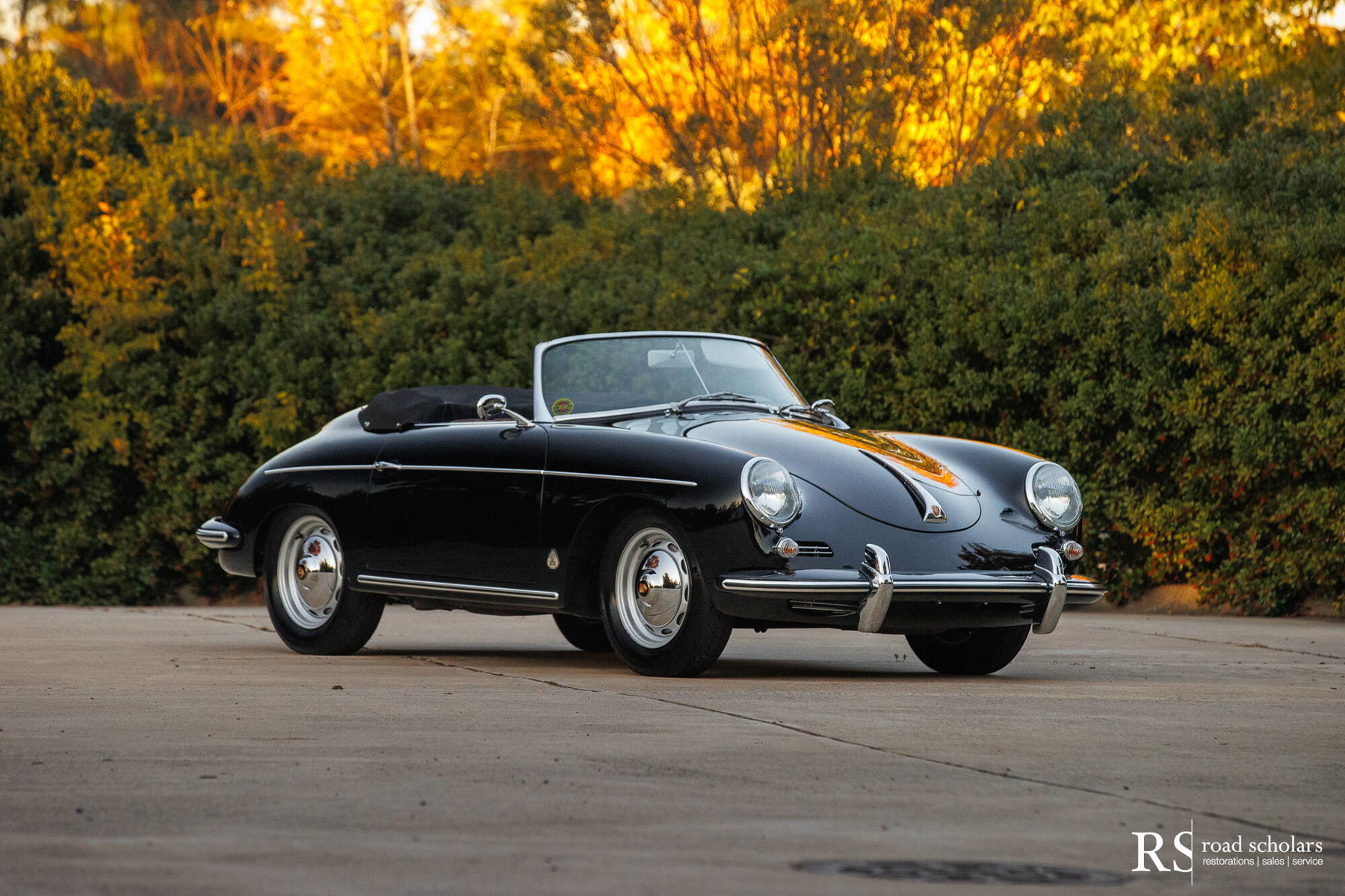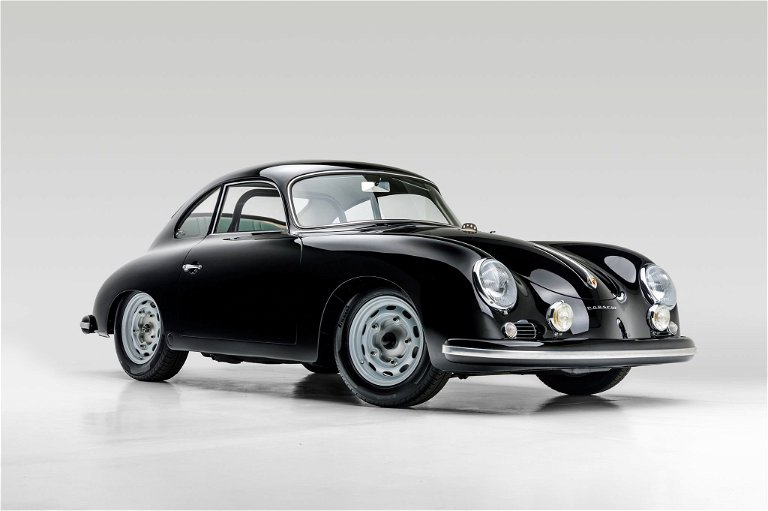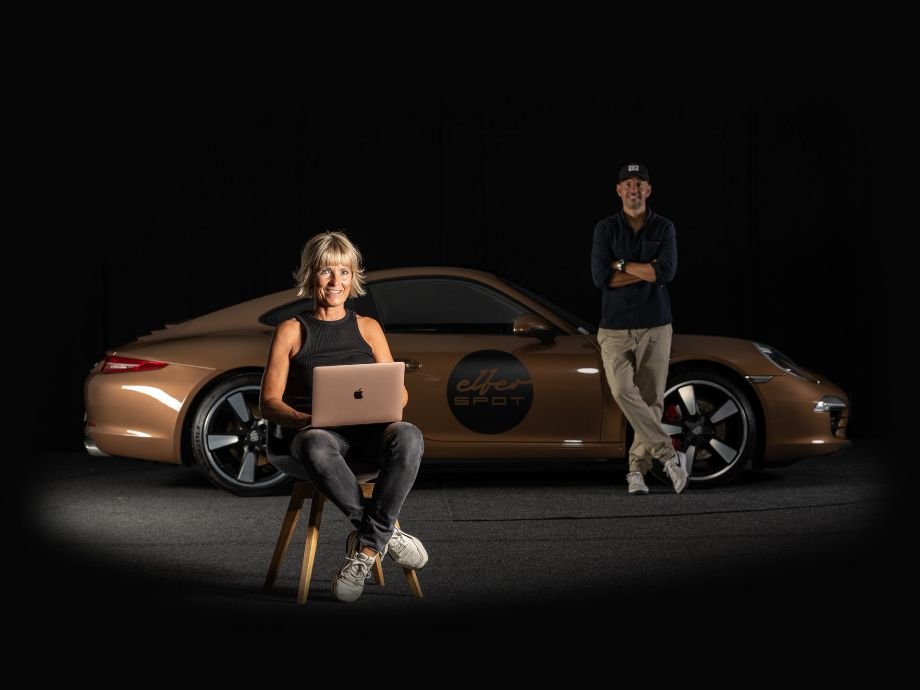The T5 body 356 B Roadster bodies were constructed at the beginning of production by the Drauz (the coachbuilder who constructed the Convertible D models) and later by the Belgian coachbuilding firm of D’Ieteren Freres S.A. in Brussels. The Type 616/7 Super 90 engine was new to the model and an indirect replacement for the Carrera de Luxe models. Super 90 engines were fitted with a new intake manifold, a larger Solex 40 PII-4 carburetor with Carrera-type air filters, along with 9.0:1 pistons, stronger valve springs, and a different crankshaft with 55mm main bearings.
This example, chassis 88234 was constructed by Drauz and left the Porsche factory on August 3, 1960, with silver paintwork and a black interior. It was configured with optional reclining seats, seat belts, two loudspeakers, an antenna, sound suppression, and a cabriolet top. It left the factory with engine number 801132 and gearbox number 39212. The Kardex notes a replacement engine numbered 801318, performed at the Porsche Factory just two days after taking delivery of the car.
It was purchased new by Konrad Bors of Los Angeles, CA for a total purchase price of $3,509.90 through Autohaus Wolfgang Hanknel & Nierich KG. in Hanau, Germany. Just after placing the order, Konrad was informed that Porsche had raised its prices by approximately 5% on all of its cars, so his new purchase price was $3,686.90. Nevertheless, Konrad moved forward with the order and took delivery of the car in Germany while doing his internship as a doctor.
Konrad drove the car from Frankfurt to Stuttgart to have a Becker (stereo) radio installed in the dash and noticed that the Roadster was consuming fuel at an unusually high rate. When he arrived at the Porsche factory on Monday night, he ran out of fuel right in front of the factory itself. He noticed some workers outside drinking beer at the gas station across the street and went over to ask them in his best German about getting some gas. Apparently, the sentiment toward Americans was still not favorable, and his bad German betrayed him- the workers flatly said they were closed and he slept in the car outside the museum until morning. He brought in the car to the Porsche Repair factory, where the original diagnosis was that it needed a new carburetor. A factory technician took the car for a test drive car with Konrad and noticed an engine knock at 110MPH. Konrad said he was horrified the technician was driving that fast as the car was supposed to be broken in gently for the first thousand miles or so.
The factory technician said they needed to replace the engine and that Konrad should come back the next day at 7 a.m. and the car would be ready. So he did, and the new engine had been installed overnight (on Warranty). The original engine (801132) was replaced with a new engine (801319 – Kardex in apparent error with 801318). Konrad also asked them to install the Becker radio as it had not been installed when he purchased the car, so the Porsche factory also installed the radio in the dash. The odometer reading on Kardex shows 770, but it is highly likely that the mileage was recorded in kilometers as the distance from Frankfurt to Stuttgart is roughly 150 miles. Konrad also recalled his fondest memories of his time with the Roadster as being those spent on the Autobahn with the speedometer wound past the 120mph mark and the needle pointing to the “VDO” logo.
For the next six weeks, Konrad drove the Roadster around Europe. During a routine service in Switzerland, the Porsche Technician who was working on the car invited Konrad to join him on the test drive. Konrad recalls the technician accelerating quickly up to 70mph in a congested area and taking turns at 90mph. He noted that the technician knew every inch of the route by heart and drove the Roadster accordingly- pushing the car as hard as possible through each turn. Konrad ended up on the French side of the English Channel and had the car flown over to England on a plane that held four cars and just six passengers. Once there, he spent time with relatives for the next six weeks but only drove the Roadster a handful of times because he found it difficult to drive with the steering wheel on the wrong side. After his stay, Konrad sailed back to New York on the Holland America line on the “New Amsterdam” ship with the car booked as excess luggage for an additional $150 fee.
Once Konrad arrived at the port in New York, he set out driving toward his home in Los Angeles via the southern route. At one point near New Mexico, he came across a patch of black ice and spun at least one full 360 before coming to rest on the side of the road, all with a hitchhiker in the passenger seat. There was no damage to the car or its occupants, but Konrad noted that the hitchhiker was scared to death. Konrad’s ownership of the Roadster came to an end in 1964, selling the car to purchase a 1964 square back VW for him and his new wife.
In the 1970s Mark Ruiz purchased the roadster and sent the car to Carrera Auto Body in San Diego, where he had any areas of rust repaired and had the car painted yellow. He spent over a decade driving and enjoying the car throughout California. Late in his ownership, the car was taken down to bare metal again and painted black. Larry Maynard purchased the car from Mark Ruiz in Costa Mesa, CA, and became the owner of the Roadster in the early 1980s. He knew Don and Gary Emory, and commissioned the two to perform a complete rotisserie restoration of the car. The restoration took a total of four years. After its completion in 1994, Larry took great care of the car while driving it regularly for the next year. He sold the car in 1995 to a dentist in Arizona named Robert Price. Between 1995 and 2001, he regularly serviced the car before it passed on to David Miller in Detroit, MI. It was awarded the Blue Ribbon at the Bay Harbor Concours in 2004, and continued to perform repairs and improvements to the car, including a complete transmission rebuild by Vic Skirmants in 2005. It was shown at various Concours and shows until 2010, where it was awarded the 3rd place ribbon in its class Concours d’Elegance of America at Meadowbrook, Rochester Hills, MI.
In 2011, Ronald De Koven purchased the car to car to have it shipped to London, where he maintains an office as a barrister. He had California Porsche Restoration renew a number of items in the interior, including recovering the interior and dashboard with new Palomino leather, a new convertible top, new carpeting, and seatbelts. Six months later, he had an extensive mechanical service done by California Porsche Restorations before the car was consigned through Road Scholars, where it was purchased by its most recent owner. Since acquiring the car, the most recent owner has meticulously maintained the car, performing much of the work himself. In addition, he has documented each and every service and repair performed in detail, as well as seeking out and documenting a cache of the car’s earlier repairs and history.
It is a show-condition driver example and is one of 528 Drauz-bodied Roadsters built for global distribution and one of approximately 132 S90 Roadsters ever built. It is fully serviced and ready to hit both the road and show circuit with a new owner.


































































































